Cigar Box Guitar #1, Part I
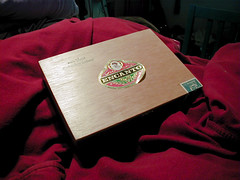 Until I scrape together the cash to buy the rest of the hardware for my tenor banjo, I'm going to have a go at making a cigar box guitar. I'm making the scale a mandola-ish sort of length (17.5 inches) and giving it four strings.
Until I scrape together the cash to buy the rest of the hardware for my tenor banjo, I'm going to have a go at making a cigar box guitar. I'm making the scale a mandola-ish sort of length (17.5 inches) and giving it four strings.There are quite a few people building cigar boxes out there, and there seems to be a bit of reverse snobbery around these instruments ("All you need is a box and a plank!", "Who needs to pay hundreds of dollars for one of them Martins when you can make a cigar box guitar at home in an afternoon!" "Listen to what I can do with three strings!", et cetera.)
I can understand the appeal of throwing together a functional instrument very quickly; it feels like I've been working on my tenor banjo forever. However, I'm not particularly interested in going to the "box and plank" extreme; I want something that I'll want to look at and play for more than an hour or two once it's complete.
Cigar box instruments seem like a good niche for a novice like me:
- I can practice just about any aspect of building "real" instruments except for the body itself; neck, joints, inlay, finishing.
- If I screw up somewhere, chances are good I'll only be out a few bucks.
- Were I to start selling these things, expectations of fit and finish would be considerably lower than if I were making dreadnought clones, yet I could probably price them high enough to make a bit of profit which I could turn around and invest in tools and supplies for "real" instrument work.
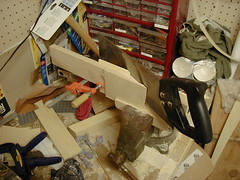 One of the first things I did was to make a miter box for cutting a low-angle scarf joint for the neck peghead joint. 15 degrees is the traditional angle, but my wooden, hand-cut miter box turned about a couple of degrees more acute than that.
One of the first things I did was to make a miter box for cutting a low-angle scarf joint for the neck peghead joint. 15 degrees is the traditional angle, but my wooden, hand-cut miter box turned about a couple of degrees more acute than that.For an instrument like this, I'm not particularly bothered by it. It means a little bit less surface area for the joint, but it should certainly be fine for nylon strings. When I move up to guitar necks I'll invest the time and money in making a jig like the one that Kathy Matsushita uses.
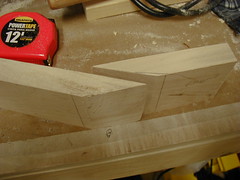 The joint came out surprisingly clean despite being hand-cut with my rickety box.
The joint came out surprisingly clean despite being hand-cut with my rickety box.I did a bit of sanding and then drilled a 1/4 hole more or less perpendicular to the joint, through both pieces. I glued everything up with a piece of 1/4 dowel through the hole. I'm not sure how much extra strength it will actually add to the joint, but I know I've seen it done on a couple of lutherie pages out there.
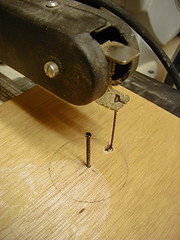 My dad will be gratified to know that I've already found a use for the old jigsaw he gave me last month. I used this saw on innumerable Cub Scout projects twenty plus years ago, and bringing it home was a bit like seeing an old friend again.
My dad will be gratified to know that I've already found a use for the old jigsaw he gave me last month. I used this saw on innumerable Cub Scout projects twenty plus years ago, and bringing it home was a bit like seeing an old friend again.To cut the soundhole I put a nail through the pivot point of the cigar box lid into a scrap of wood bolted to the jigsaw table, positioning everything so that the blade fell exactly at the outer radius of the circle from the pivot.
I also drilled a small hole in the lid ahead of time to let the blade through.
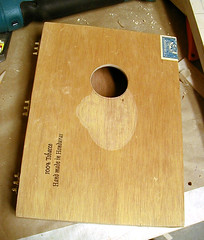 Both of my soprano ukes' soundholes are 1.75 inches in diameter, so I decided to start there. I haven't decided whether it looks a tad too small or not.
Both of my soprano ukes' soundholes are 1.75 inches in diameter, so I decided to start there. I haven't decided whether it looks a tad too small or not.There is quite a lot of information out there about the physics of soundholes and soundboxes, but not being a physicist a lot of it is over my head (not to mention overkill for a cigar box.) One thing I took away from what little reading I did is that too large of a soundhole relative to the size of the air chamber means poor response from the instrument top. Since you can always take more wood off, but you can never put it back on, 1.75 inches it is.
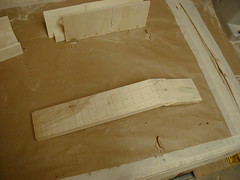 After the neck joint dried I cut the fret slots. I'm not using a fingerboard for this instrument, so I cut the slots before profiling the neck; much easier to make perpendicular cuts that way. It would have been even easier if I had cut the slots before gluing the peghead joint; that way the neck would have sat flat in the miter box.
After the neck joint dried I cut the fret slots. I'm not using a fingerboard for this instrument, so I cut the slots before profiling the neck; much easier to make perpendicular cuts that way. It would have been even easier if I had cut the slots before gluing the peghead joint; that way the neck would have sat flat in the miter box.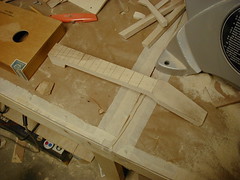 After gluing on another small block of wood at the heel, and putting a maple veneer on the peghead to cover up the scarf joint, I went ahead and trimmed the neck profile and peghead outline.
After gluing on another small block of wood at the heel, and putting a maple veneer on the peghead to cover up the scarf joint, I went ahead and trimmed the neck profile and peghead outline.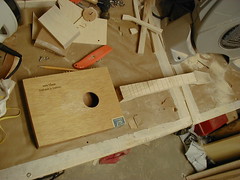 Compared to the stop-and-start progress on my still-incomplete tenor banjo, this thing is coming together lightning fast. This is at how things looked after two sessions in the workshop.
Compared to the stop-and-start progress on my still-incomplete tenor banjo, this thing is coming together lightning fast. This is at how things looked after two sessions in the workshop.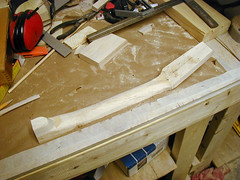 After a busy week I was eager to get back to this project in hopes of getting it strung this weekend. Maybe a little too eager; I tried using the bandsaw at an angle to rough out angles along the neck that will eventually be curves, and trimmed a little more away than I really wanted.
After a busy week I was eager to get back to this project in hopes of getting it strung this weekend. Maybe a little too eager; I tried using the bandsaw at an angle to rough out angles along the neck that will eventually be curves, and trimmed a little more away than I really wanted.The thing I need to keep reminding myself is that I've already spent considerably more time on this thing than many people would, and that the neck will be perfectly functional despite being a little bit uneven in those spots.
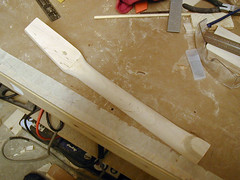 Sanding has gone fairly quickly, although there's a stubborn spot of glue down at the heel block, and as always there are a few bandsaw nicks that may be deep enough to require filler, rather than sanding down everything around them. I need to get a bandsaw blade with a closer set.
Sanding has gone fairly quickly, although there's a stubborn spot of glue down at the heel block, and as always there are a few bandsaw nicks that may be deep enough to require filler, rather than sanding down everything around them. I need to get a bandsaw blade with a closer set.
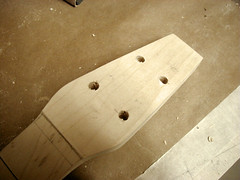
2 Comments:
Great stuff - maybe you'd like to see some of my CBG's - take a look at:-
http://smojo-cigar-box-guitars.blogspot.com/
Hi Andy,
I'm building my first Cigar Box Ukulele and your blog and photographs have been fantastic help.
Thank You for posting it!
-Shelley.
Post a Comment
<< Home